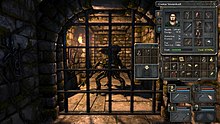Dungeon crawl

Adungeon crawlis a type of scenario infantasyrole-playing games(RPGs) in which heroes navigate alabyrinthenvironment (a "dungeon"), battling various monsters, avoiding traps, solving puzzles, and looting any treasure they may find.[1]Video gamesandboard gameswhich predominantly feature dungeon crawl elements are considered to be agenre.[1][2][3]
Board games
[edit]Dungeon crawling in board games dates to 1975 whenGary GygaxintroducedSolo Dungeon Adventures.[citation needed]That year also saw the release ofDungeon!.Over the years, many games built on that concept.[4]One of the most acclaimed board games of the late 2010s,Gloomhaven,is a dungeon crawler.[3][5]
Video games
[edit]
The first computer-based dungeon crawl waspedit5,developed in 1975 by Rusty Rutherford on thePLATO interactive education systembased inUrbana, Illinois.Although this game was quickly deleted from the system, several more like it appeared, includingdndandMoria.[1]
Computer games and series from the 1980s, such asRogue,The Bard's Tale,Cosmic Soldier,Dungeon Master,Gauntlet,Madō Monogatari,Megami Tensei,Might and Magic,Legend of Zelda,Phantasy Star,Ultima,andWizardry,helped set the standards of the genre. Their primitive graphics were conducive to this style, due to the need for repetitive tiles or similar-looking graphics to create effective mazes.Game Developer's Matt Barton describedTelengard(1982) as a "pure dungeon crawler" for its lack of diversions, and noted its expansive dungeons as a "key selling point".[6]
Some dungeon crawlers from this era also employedaction role-playing gamecombat, such asDragon Slayer,[7]andThe Tower of Druaga.[8]Games that grew out of this style are also considered dungeon crawlers, in that the player is limited to the confines of the walls of the dungeon, but still allows for complex systems around combat, enemy behavior, and loot systems, as well as the potential for multiplayer and online play.Gauntlet,Diablo,The Binding of IsaacandEnter the Gungeonare examples of these dungeon crawlers.[9]
Variations on the dungeon crawltropecan be found in othergenres.In the early 2010s there was a modest resurgence in their popularity, particularly in Japan, largely due to the success of theEtrian Odysseyseries byAtlus.[10]
Instance dungeon
[edit]Inmassively multiplayer online games,aninstanceis a special area, typically a dungeon or a restricted dungeon-like environment, that generates a new copy of the location for each group or certain number of players that enters the area.[11]Instancing, the general term for the use of this technique,[11]addresses several problems encountered by players in the shared spaces ofvirtual worlds,but also sacrifices the social element of shared spaces and realistic immersion in that virtual world. They also tend to be a lot smaller and more linear.
First-person party-based dungeon crawlers
[edit]
This subgenre consists of RPGs where the player leads a party of adventurers infirst-person perspective,typically in a grid-based environment. Examples include the aforementionedWizardry,Might and MagicandBard's Taleseries; as well as theEtrian OdysseyandElminageseries. Games of this type are also known as "blobbers", since the player moves the entire party around the playing field as a single unit, or "blob".[13][14]
Many "blobbers" are turn-based, such as theplay-by-mailgameHeroic Fantasy,but some games such asDungeon Master,Legend of GrimrockandEye of the Beholderseries are played in real-time. Early games in this genre lack anautomapfeature, forcing players to draw their own maps in order to keep track of their progress. Spatial puzzles are common, and players may have to, for instance, move a stone in one part of the level in order to open a gate in another part of the level.[citation needed]
See also
[edit]References
[edit]- ^abcBrewer, Nathan (7 July 2016)."Going Rogue: A Brief History of the Computerized Dungeon Crawl".IEEE-USA InSight.Archivedfrom the original on 10 January 2020.Retrieved10 January2020.
- ^"Category: Dungeon Crawler | Family | BoardGameGeek".boardgamegeek.Retrieved2021-10-25.
- ^ab"10 best dungeon-crawler games you should delve into next".Dicebreaker.2020-06-22.Retrieved2021-10-25.
- ^"Chronological List of Dungeon Crawlers | BoardGameGeek".boardgamegeek.Retrieved2021-10-25.
- ^Theel, Charles (2021-10-13)."Gloomhaven's digital adaptation is a marvelous turn-based dungeon crawler".Polygon.Retrieved2021-10-25.
- ^Barton, Matt (February 23, 2007)."The History of Computer Role-Playing Games Part 1: The Early Years (1980-1983)".Game Developer.UBM Tech.Archivedfrom the original on 2021-08-27.RetrievedAugust 30,2014.
- ^Kalata, Kurt."Dragon Slayer".Retrieved10 January2020.
- ^Parish, Jeremy (30 July 2012)."What Happened to the Action RPG?".1UP.Archived fromthe originalon 3 October 2018.Retrieved10 January2020.
- ^Stuart, Keith (October 11, 2021)."Dungeon crawler or looter shooter? Nine video game genres explained".The Guardian.RetrievedOctober 12,2021.
- ^Parish, Jeremy (2011-09-15)."TGS: Beyond the Labyrinth is Beautiful But Puts the" Crawl "in" Dungeon-Crawler. "(Nintendo 3DS) - Konami's new 3DS RPG is probably too specific to Japanese tastes to come to the U.S."1UP.Archived fromthe originalon 28 November 2011.Retrieved16 September2011.
- ^abSimon Carless (2004).Gaming hacks.O'Reilly Media. p. 112.ISBN978-0-596-00714-0.
A term used to describe a private portion of a gameworld created just for an individual or group of players.
- ^Edge Staff (2012-04-12)."Legend Of Grimrock review".Edge.Archived fromthe originalon July 10, 2012.Retrieved2012-05-09.
- ^Cobbett, Richard (December 5, 2016)."The RPGs of 2017".Rock Paper Shotgun.Retrieved2017-05-22.
- ^Pepe, Felipe (June 25, 2015)."CRPG History Abridged - 21 RPGs that brought something new to the table".Game Developer.UBM.Retrieved2017-05-22.
